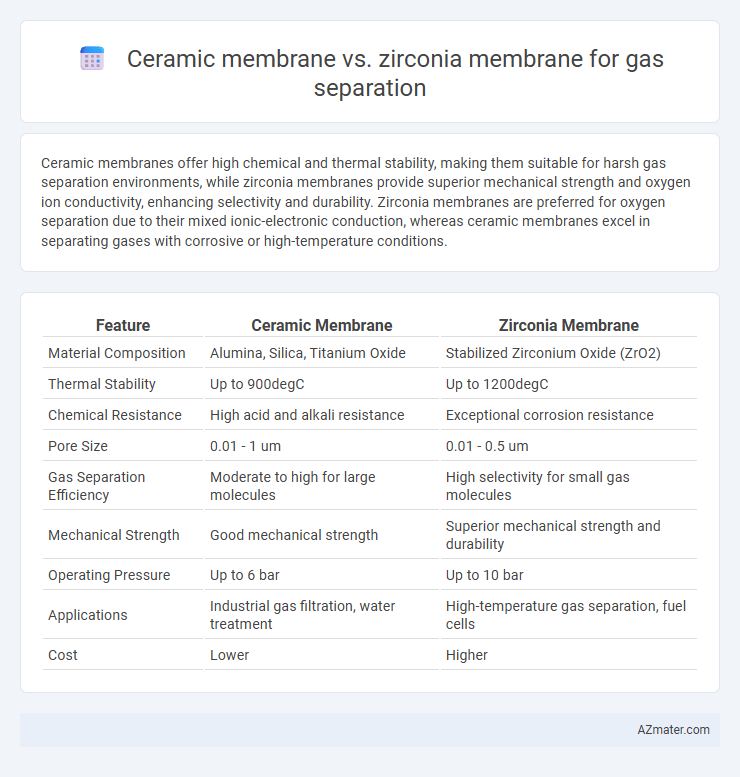Ceramic membranes offer high chemical and thermal stability, making them suitable for harsh gas separation environments, while zirconia membranes provide superior mechanical strength and oxygen ion conductivity, enhancing selectivity and durability. Zirconia membranes are preferred for oxygen separation due to their mixed ionic-electronic conduction, whereas ceramic membranes excel in separating gases with corrosive or high-temperature conditions.
Table of Comparison
| Feature | Ceramic Membrane | Zirconia Membrane |
|---|---|---|
| Material Composition | Alumina, Silica, Titanium Oxide | Stabilized Zirconium Oxide (ZrO2) |
| Thermal Stability | Up to 900degC | Up to 1200degC |
| Chemical Resistance | High acid and alkali resistance | Exceptional corrosion resistance |
| Pore Size | 0.01 - 1 um | 0.01 - 0.5 um |
| Gas Separation Efficiency | Moderate to high for large molecules | High selectivity for small gas molecules |
| Mechanical Strength | Good mechanical strength | Superior mechanical strength and durability |
| Operating Pressure | Up to 6 bar | Up to 10 bar |
| Applications | Industrial gas filtration, water treatment | High-temperature gas separation, fuel cells |
| Cost | Lower | Higher |
Introduction to Gas Separation Membranes
Gas separation membranes utilize selective permeability to separate specific gases from mixtures, enhancing industrial gas processing efficiency. Ceramic membranes, primarily made of alumina or silica, offer high thermal stability and chemical resistance suitable for harsh conditions. Zirconia membranes, a subclass of ceramic membranes, provide superior mechanical strength and oxygen ion conductivity, making them ideal for high-temperature gas separation applications like oxygen enrichment and hydrogen purification.
Overview of Ceramic Membranes
Ceramic membranes, including zirconia membranes, are widely used for gas separation due to their high thermal stability, chemical resistance, and mechanical strength. Zirconia membranes offer superior oxygen ion conductivity and selectivity, making them ideal for oxygen separation and other gas separation applications. Ceramic membranes generally provide longer operational lifetimes and improved performance under harsh conditions compared to polymer membranes.
Understanding Zirconia Membranes
Zirconia membranes exhibit exceptional thermal stability and chemical resistance, making them ideal for gas separation processes involving harsh environments. Their unique microstructure allows selective permeability, efficiently separating specific gas molecules such as oxygen or hydrogen from mixtures. Compared to ceramic membranes, zirconia membranes offer enhanced durability and separation performance, particularly in high-temperature and corrosive gas applications.
Material Properties: Ceramic vs Zirconia Membranes
Ceramic membranes for gas separation typically offer excellent thermal stability and chemical resistance, making them suitable for harsh industrial environments. Zirconia membranes, a subset of ceramic membranes, exhibit superior mechanical strength and higher oxygen ion conductivity, enhancing selectivity and permeability in oxygen separation processes. The intrinsic material properties of zirconia, including its crystalline structure and oxygen vacancy concentration, provide enhanced durability and efficiency compared to conventional ceramic membranes.
Gas Permeability and Selectivity Comparison
Ceramic membranes, typically composed of alumina or silica, offer moderate gas permeability with good thermal and chemical stability, but zirconia membranes exhibit higher gas permeability due to their unique crystalline structure and pore size distribution. Zirconia membranes generally demonstrate superior selectivity in gas separation processes, particularly for hydrogen and oxygen separation, attributed to their enhanced molecular sieve properties and lower defect density. Performance metrics indicate that zirconia membranes achieve higher H2/N2 and O2/N2 selectivity, making them more suitable for applications requiring precise gas discrimination and efficient separation.
Thermal and Chemical Stability Analysis
Ceramic membranes, primarily composed of alumina or silica, exhibit high thermal stability, maintaining structural integrity at temperatures exceeding 1000degC, making them suitable for harsh gas separation environments. Zirconia membranes demonstrate superior chemical resistance against corrosive gases such as sulfur compounds and have enhanced thermal shock resistance due to their tetragonal phase stability up to approximately 1200degC. Both membranes offer excellent durability, but zirconia's higher resistance to chemical degradation and thermal cycling outperforms traditional ceramic options in aggressive gas separation applications.
Applications in Industrial Gas Separation
Ceramic membranes exhibit high thermal and chemical stability, making them suitable for separating aggressive gases in industries such as petrochemical refining and hydrogen purification. Zirconia membranes offer exceptional oxygen ion conductivity, enabling efficient oxygen separation at elevated temperatures, critical for processes like syngas production and combustion air enrichment. Both membrane types enhance industrial gas separation by improving selectivity and durability under harsh operational conditions.
Cost-effectiveness and Lifespan Evaluation
Ceramic membranes generally offer higher cost-effectiveness due to their lower initial price and durability under harsh operational conditions compared to zirconia membranes. Zirconia membranes, while more expensive upfront, provide superior chemical resistance and thermal stability, leading to extended lifespan in aggressive gas separation environments. Evaluating total cost of ownership, ceramic membranes often present better value for standard applications, whereas zirconia membranes justify their higher cost through longevity in specialized, high-temperature processes.
Challenges and Limitations of Each Membrane
Ceramic membranes face challenges such as brittleness and thermal expansion mismatch, which can lead to structural failure under fluctuating temperatures during gas separation processes. Zirconia membranes exhibit limitations in chemical stability against certain acidic gases and may experience reduced permeability due to grain boundary resistance. Both membrane types require precise fabrication control to minimize defects and ensure long-term operational durability in industrial gas separation applications.
Future Trends in Gas Separation Membrane Technologies
Ceramic membranes and zirconia membranes both exhibit high thermal stability and chemical resistance, making them ideal for advanced gas separation applications in harsh environments. Future trends indicate a growing emphasis on enhancing membrane selectivity and permeability through nanostructuring and hybrid material integration, particularly leveraging zirconia's superior mechanical strength and resistance to fouling. Innovations in scalable manufacturing and membrane module design are expected to reduce costs and improve the efficiency of industrial gas separation processes, supporting cleaner energy production and carbon capture technologies.

Infographic: Ceramic membrane vs Zirconia membrane for Gas separation
 azmater.com
azmater.com